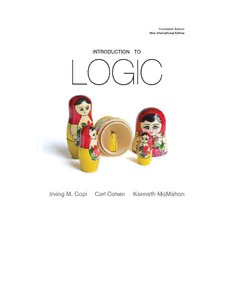
Introduction to logic PDF
Preview Introduction to logic
Logic Overview I–Syllogistic Terms (see Chapter 6) Every standard-form categorical syllogism has exactly three terms, to wit: The major term is the predicate term of the conclusion (P). The minor term is the subject term of the conclusion (S). The middle term is the term appearing in both premises but not in the conclusion (M). The premise in which the major term appears is the major premise. The premise in which the minor term appears is the minor premise. A syllogism is in standard form when its three propositions are in exactly this order: major premise, minor premise, conclusion. Every proposition in a categorical syllogism must be one of the following four: An A proposition—universal affirmative (e.g., All politicians are liars.) An E proposition—universal negative (e.g., No politicians are liars.) An I proposition—particular affirmative (e.g., Some politicians are liars.) An O proposition—particular negative (e.g., Some politicians are not liars.) The mood of a syllogism is determined by the types of its three propositions, AAA, EIO, etc. The figure of a standard-form syllogism is determined by the position of its middle term: 1st: Middle term is the subject of the major premise and the predicate of the minor premise. 2nd: Middle term is the predicate of both premises. 3rd: Middle term is the subject of both premises. 4th: Middle term is the predicate of the major premise and the subject of the minor premises. Logic Overview II—Valid Forms of the Categorical Syllogism (see Chapter 6) Any syllogistic form is completely determined by the combination of its mood and figure. There are exactly 15 valid forms of the categorical syllogism, each with a unique name: Rules governing every valid categorical syllogism: 1. The syllogism must contain exactly three terms, used consistently. 2. The middle term of the syllogism must be distributed in at least one premise.* 3. If either term is distributed in the conclusion, it must be distributed in the premises.* 4. A valid syllogism cannot have two negative premises. 5. If either premise of the syllogism is negative, the conclusion must be negative. 6. From two universal premises no particular conclusion may be drawn. Logic Overview III—The Seven Stages of Scientific Investigation: The Scientific Method (see Chapter 13) 1. Identify the problem 2. Devise preliminary hypotheses 3. Collect additional facts 4. Formulate a refined explanatory hypothesis 5. Deduce consequences from the refined hypothesis 6. Test the consequences deduced 7. Apply the theory Logic Overview IV—Mill’s Methods of Inductive Inference (see Chapter 12) 1. The Method of Agreement: The one factor or circumstance that is common to all the cases of the phenomenon under investigation is likely to be the cause (or effect) of that phenomenon. A B C D occur together with w x y z. A E F G occur together with w t u v. Note * (Note: A term is distributed when the proposition in which the term appears refers to all members of the class to which the term refers. Thus, in the proposition “All humans are mortal” the term “humans” is distributed, but the term “mortal” is not.) INTRODUCTION TO LOGIC INTRODUCTION TO LOGIC FOURTEENTH EDITION Irving M. Copi University of Hawaii Carl Cohen University of Michigan Kenneth McMahon Hawaii Pacific University First published 2011, 2009, 2005, 2002, 1998 by Pearson Education, Inc. Published 2016 by Routledge 2 Park Square, Milton Park, Abingdon, Oxon OX14 4RN 711 Third Avenue, New York, NY 10017, USA Routledge is an imprint of the Taylor & Francis Group, an informa business Copyright © 2011, 2009, 2005, 2002, 1998 Taylor & Francis All rights reserved. No part of this book may be reprinted or reproduced or utilised in any form or by any electronic, mechanical, or other means, now known or hereafter invented, including photocopying and recording, or in any information storage or retrieval system, without permission in writing from the publishers. Notice: Product or corporate names may be trademarks or registered trademarks, and are used only for identification and explanation without intent to infringe. Credits and acknowledgments borrowed from other sources and reproduced, with permission, in this textbook appear on appropriate page within text (or on page 607). Many of the designations by manufacturers and seller to distinguish their products are claimed as trademarks. Where those designations appear in this book, and the publisher was aware of a trademark claim, the designations have been printed in initial caps or all caps. ISBN-13: 9780205820375 (hbk) Library of Congress Cataloging-in-Publication Data Copi, Irving M. Introduction to logic. — 14th ed./Irving M. Copi, Carl Cohen, K. D. McMahon. p. cm. Includes index. 1. Logic—Textbooks. I. Cohen, Carl, 1931- II. McMahon, K. D. (Kenneth D.) III. Title. BC108.C69 2011 160—dc22 2010036272 We dedicate this fourteenth edition of Introduction to Logic to the many thousands of students and their teachers, at hundreds of universities in the United States and around the world, who have relied on earlier editions of the book, and have greatly helped to improve it, over five decades. Brief Contents Part I LOGIC AND LANGUAGE SECTION A REASONING chapter 1 Basic Logical Concepts chapter 2 Analyzing Arguments SECTION B INFORMAL LOGIC chapter 3 Language and Definitions chapter 4 Fallacies Part II DEDUCTION SECTION A CLASSICAL LOGIC chapter 5 Categorical Propositions chapter 6 Categorical Syllogisms chapter 7 Syllogisms in Ordinary Language SECTION B MODERN LOGIC chapter 8 Symbolic Logic chapter 9 Methods of Deduction chapter 10 Quantification Theory Part III INDUCTION SECTION A ANALOGY AND CAUSATION chapter 11 Analogical Reasoning chapter 12 Causal Reasoning SECTION B SCIENCE AND PROBABILITY chapter 13 Science and Hypothesis chapter 14 Probability
